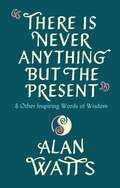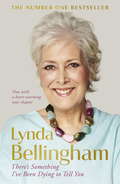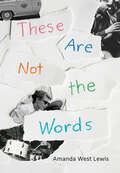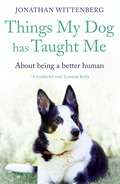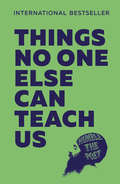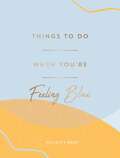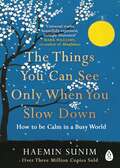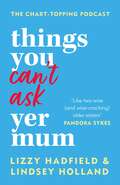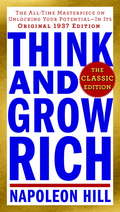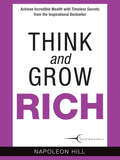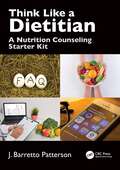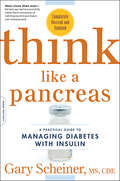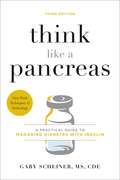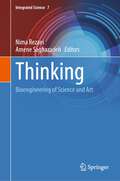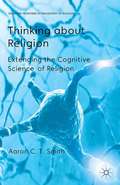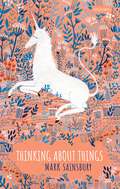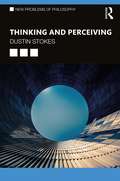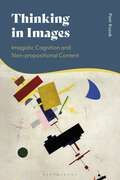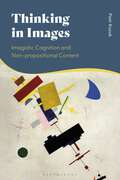- Table View
- List View
Therapy Outcome Measure User Guide and Scales
by Pamela Enderby and Alexandra JohnThe Therapy Outcome Measure (TOM) allows rehabilitation professionals to describe the relative abilities and difficulties of a patient/client in the four domains of impairment, activity, participation and wellbeing in order to monitor changes over time.
There Is Never Anything But The Present: & Other Inspiring Words of Wisdom
by Alan Watts'The perfect guide for a course correction in life' Deepak ChopraFor decades, people have turned to the inspiring words of pioneering Zen scholar Alan Watts for guidance, support and spiritual sustenance. In this thought-provoking collection of aphorisms and quotations, Watts reminds us all to slow down, to recognize we are not the universe but part of it and to enjoy each moment that composes our lives. This is a timeless work to reflect upon, to live by and to read for inspiration, knowledge and growth.
There is No Me Without You: One Woman's Odyssey to Rescue Africa's Children
by Melissa Fay GreeneTwo-time National Book Award nominee Melissa Fay Greene puts a human face on the African AIDS crisis with this powerful story of one woman working to save her country's children. After losing her husband and daughter, Haregewoin Teferra, an Ethiopian woman of modest means, opened her home to some of the thousands of children in Addis Ababa who have been left as orphans. There Is No Me Without You is the story of how Haregewoin transformed her home into an orphanage and day-care center and began facilitating adoptions to homes all over the world, written by a star of literary nonfiction who is herself an adoptive parent. At heart, it is a book about children and parents, wherever they may be, however they may find each other.
There's Something I've Been Dying to Tell You: The uplifting bestseller
by Lynda BellinghamBy turns, it is riotous, deeply serious, practical and sad. Reading it is like being at her kitchen table with a glass of wine to hand. (Daily Telegraph)Lynda Bellingham was a tremendously gifted storyteller with a rich collection of tales of love, loss and laughter and this memoir brings her kind heart, courage and emotion to the page in vivid detail. There's Something I've Been Dying To Tell You is a brave memoir about Lynda's battle with cancer, facing death she found joy and shared it with millions. Her story is an affecting and at times heart-breaking one but it is so often laugh-out-loud too and ultimately the way Lynda told her life story serves as a great inspiration to us all. Woven into this very moving and brave story are extraordinary, colourful tales of her acting and family life that will enlighten and entertain as well as the journey that Lynda has taken to find the family of her birth father having already suffered heartache in her search for her birth mother. In the search for her father's family, Lynda finds a family with a history in entertainment showing that acting was always in the blood.This book was written in Lynda's final months and revealed for the first time, and in great detail, her fight with cancer and how her life was transformed since her diagnosis. This edition includes a brand new chapter written by Lynda's husband Michael about his love for her, her love of life and her glorious final send-off.
These Are Not the Words
by Amanda West LewisNew York City in the 1960s is the humming backdrop for this poignant, gritty story about a girl who sees her parents as flawed human beings for the first time, and finds the courage to make a fresh start. Missy’s mother has gone back to school to pursue her dream of becoming an artist. Missy’s father works in advertising and takes Missy on secret midnight excursions to Harlem and the Village so she can share his love of jazz. The two write poems for each other — poems that gradually become an exchange of apologies as Missy’s father’s alcohol and drug addiction begins to take over their lives. When Missy’s mother finally decides that she and her daughter must make a fresh start, Missy has to leave her old apartment, her school, her best friend and her cats and become a latchkey kid while her mother gets a job. But she won’t give up on trying to save her family, even though this will involve a hard journey from innocence to action, and finally acceptance. Based on the events and people of her own childhood, Amanda Lewis’s gorgeous novel is driven by Missy’s irresistible, optimistic voice, buoyed by the undercurrents of poetry and music. Key Text Features poems dialogue literary references epigraph vignettes
Thin Thighs in 30 Days
by Wendy StehlingTHE INSPIRATIONAL NUMBER ONE BESTSELLERBased on the very latest diet and fitness research, this classic New York Times bestseller is fast, fun and effective - and in three simple steps it shows you how you can have the super sexy, thin thighs you've always wanted... THE WORK OFFWhatever your level of fitness, here you will find proven exercises, and stretch and tone programme that packs a punch in terms of its fat-busting, muscle-toning power...THE WALK OFFDiscover all-important tips on how to make every step count. There's even an interval-training component to help you get more bang for your exercise buck!THE WEIGHT OFFA simple diet plan, up-to-the-minute nutritional advice, will help you to maximize your exercise programme and reach your goal.Fully illustrated and complete with a set of diaries to help you to keep on track, this bestselling diet and exercise programme provides all you need to achieve your ultimate dream - Thin Thighs in 30 Days.
Things My Dog Has Taught Me: About being a better human
by Jonathan Wittenberg'A wonderful read' -- Lorraine KellyIn this book for dog lovers everywhere, Jonathan Wittenberg says his dogs have taught him, more than anything else, how to appreciate the wonderful world in which we live -- and how to develop better relationships with his friends and families. In this wonderful, warm account of one man and his dog, Jonathan brings all the big themes of friendship, faithfulness, kindness, cruelty, grief, prayer and spiritual companionship to the fore, and shows us how we can learn so much from a dog's approach to life. If you're one of the 8.5 million dog owners in the UK the answer to a better way of living may already be under your roof.
Things No One Else Can Teach Us: Turning Losses Into Lessons
by Humble the PoetCreate your own silver linings.
Things to Do When You're Feeling Blue: Self-Care Ideas to Make Yourself Feel Better
by Felicity HartReplace good vibes only with I’m allowed to feel sadReplace delete negativity with I can reach out for supportReplace I’m no good at anything with Would I say this to a friend?A break in the clouds, a hug at the right moment, the small voice in the back of our heads that says, “I can do this.” Those moments are the rich soil in which we grow our self-esteem, our resilience and our relish for life. This book is filled with dozens of these little moments, ready to be dipped into whenever your mood dips, and to be opened up when you’re shutting down.From ways to identify burnout and strategies for combating negative self-talk, to simple scripts for tricky situations and soothing self-care rituals, this is a book that will take you by the hand and tell what you need to hear. Even if what you need to hear is “it’s okay to wrap yourself in a duvet burrito for the day”.Even at your most flawed, you’re perfectly you. Even when you feel broken, you’re whole. You’re brilliant, unique and worthy. It’s time to leave the blue moods behind and experience the full rainbow.
The Things You Can See Only When You Slow Down: Bring calm to your life with the ultimate mindfulness guide from a Buddhist monk
by Haemin SunimThe world moves fast, but that doesn't mean we have to. In this timely guide to mindfulness, Haemin Sunim, a Buddhist monk born in Korea and educated in the United States, offers advice on everything from handling setbacks to dealing with rest and relationships, in a beautiful book combining his teachings with calming full-colour illustrations. Haemin Sunim's simple messages - which he first wrote when he responded to requests for advice on social media - speak directly to the anxieties that have become part of modern life and remind us of the strength and joy that come from slowing down.Hugely popular in Korea, Haemin Sunim is a Zen meditation teacher whose teachings transcend religion, borders and ages. With insight and compassion drawn from a life full of change, the 'mega-monk' succeeds at encouraging all of us to notice that when you slow down, the world slows down with you.
Things You Can't Ask Yer Mum
by Lindsey Holland Lizzy Hadfield'Like two wise (and wise-cracking) older sisters. I wish I'd had this book 15 years ago.' - Pandora SykesHeartbreak, grief, falling in love, falling out of love, friendships, disastrous sex anecdotes - this book is filled with everything you don't want to ask your mum.The duo behind the chart-topping podcast Things You Can't Ask Yer Mum take a deep-dive into the ups and downs of life. Lizzy and Lindsey share the twists and turns of their own experiences in their usual hilariously honest style, offering reassurance on all the questions you just might be too afraid to ask. The book embodies what Lindsey and Lizzy have had through their friendship: the ability to honestly pass on their own experiences in life in order to help the other. With never-heard-before anecdotes and bite-sized chunks of content to return to, this valuable book will be a friend to you - one that shares reassuring stories of losing virginity using a blueberry flavoured condom, losing friends and losing inhibitions. It is a book for anyone, at any stage of life.
Think and Grow Rich: The All-Time Masterpiece on Unlocking Your Potential--In Its Original 1937 Edition
by Napoleon HillAn affordable, beautifully produced reproduction of the vintage text of Napoleon Hill's original landmark--this is the legendary program, just as it reached readers in 1937.You want to dip into Think and Grow Rich ... you've heard about it from friends and coworkers ... you see people reading it ... and you feel it's time for a change in life. But where do you start? RIGHT HERE. Think and Grow Rich: The Classic Edition is a handsome, reliable, inexpensive, and compact volume that features the full 1937 text, just as it appeared on its first day of publication, before the book lit up millions of lives and became known around the world. This is a volume you will want to read, reread, cherish--and then share with friends and loved ones. And it is priced so affordably that you can do just that. From the Trade Paperback edition.
Think and Grow Rich
by Napoleon Hill Katherine HurstThink and Grow Rich is the wildly successful motivational book from personal development author, Napoleon Hill. Having sold over 30 million copies over the past 70 years alone, this groundbreaking volume reveals the secrets of hundreds of the world's most affluent people - exposing the thought-processes and success mindset that can help you too, to enjoy unlimited prosperity and abundance. The thirteen step program found in this book has everything you need to set you on the path to incredible wealth and success. Regardless of your current circumstances, education or business experience... once you begin to read this book, you'll have access to the truths and lessons that can teach any man or woman - young or old, rich or poor - to turn their dreams for an abundant life into a reality. With this book, the formula for everything you desire - to be applied in ALL areas of life - is in your hands. Simple, direct, but incredibly powerful too - this book has the potential to change your life for the better. Are you ready? The formula for prosperity - to be applied in ALL areas of your life - is within your reach.
Think Like a Dietitian: A Nutrition Counseling Starter Kit
by J. Barretto PattersonWhile courses in nutrition counseling teach providers to listen to their patients, this book gives registered dietitian nutritionists (RDNs) a heads-up on what to listen for, with educational materials that address the everyday challenges many people, hence many RDNs, face.Split into four distinct sections, this book equips readers with comprehensive education and counseling for the most common nutrition referrals.Topics include:- How to structure a nutrition counseling session, from getting a patient to open up to empowering them with information and strategies for self‑care.- Strategies for the provider to address personal challenges such as cultivating empathy, implicit bias, and cultural competence.- Routine eating patterns and challenges reported in nutrition counseling, such as night eating, emotional eating, and more.- Common reasons for referral to a dietitian, and frequently asked questions on topics including diabetes, heart disease, kidney disease, irritable bowel syndrome, and weight counseling.- Special issues in health educationThis book is appealing to both early nutrition professionals and experienced dietitians alike, providing a holistic tool kit for RDNs of all levels of experience.
Think Like a Dietitian: A Nutrition Counseling Starter Kit
by J. Barretto PattersonWhile courses in nutrition counseling teach providers to listen to their patients, this book gives registered dietitian nutritionists (RDNs) a heads-up on what to listen for, with educational materials that address the everyday challenges many people, hence many RDNs, face.Split into four distinct sections, this book equips readers with comprehensive education and counseling for the most common nutrition referrals.Topics include:- How to structure a nutrition counseling session, from getting a patient to open up to empowering them with information and strategies for self‑care.- Strategies for the provider to address personal challenges such as cultivating empathy, implicit bias, and cultural competence.- Routine eating patterns and challenges reported in nutrition counseling, such as night eating, emotional eating, and more.- Common reasons for referral to a dietitian, and frequently asked questions on topics including diabetes, heart disease, kidney disease, irritable bowel syndrome, and weight counseling.- Special issues in health educationThis book is appealing to both early nutrition professionals and experienced dietitians alike, providing a holistic tool kit for RDNs of all levels of experience.
Think Like a Pancreas: A Practical Guide to Managing Diabetes with Insulin--Completely Revised and Updated (Marlowe Diabetes Library)
by Gary ScheinerThe all-in-one, comprehensive resource for the millions of people with diabetes who use insulin, revised and updated.Few diabetes books focus specifically on the day-to-day issues facing people who use insulin. Diabetes educator Gary Scheiner provides the tools to "think like a pancreas" -- to successfully master the art and science of matching insulin to the body's ever-changing needs. Comprehensive, free of medical jargon, and packed with useful information not readily available elsewhere, such as: Day-to-day blood glucose control and monitoringDesigning an insulin program to best match your lifestyleUp-to date medication and technologyNew insulin formulations and combinationsand moreWith detailed information on new medications and technologies -- both apps and devices -- surrounding insulin, as well as new injection devices, and dietary recommendations, Think Like a Pancreas is the insulin user's go-to guide.
Think Like a Pancreas: A Practical Guide to Managing Diabetes with Insulin (Marlowe Diabetes Library)
by Gary ScheinerThe all-in-one, comprehensive resource for the millions of people with diabetes who use insulin, revised and updatedFew diabetes books focus specifically on the day-to-day issues facing people who use insulin. Diabetes educator Gary Scheiner provides the tools to "think like a pancreas" -- to successfully master the art and science of matching insulin to the body's ever-changing needs. Comprehensive, free of medical jargon, and packed with useful information not readily available elsewhere, such as: day-to-day blood glucose control and monitoring designing an insulin program to best match your lifestyleup-to date medication and technologynew insulin formulations and combinationsand moreWith detailed information on new medications and technologies -- both apps and devices -- surrounding insulin, as well as new injection devices, and dietary recommendations, Think Like a Pancreas is the insulin users go-to guide.
Thinking: Bioengineering of Science and Art (Integrated Science #7)
by Nima Rezaei Amene SaghazadehThe “THINKING: Bioengineering of Science and Art” is to discuss about philosophical aspects of thinking at the context of Science and Art. External representations provide evidence that the fundamental process of thinking exists in both animal subjects and humans. However, the diversity and complexity of thinking in humans is astonishing because humans have been permitted to integrate scientific accounts into their accounts and create excellent illustrations for the effects of this integration. The book necessarily begins with the origins of human thinking and human thinking into self and others, body, and life. Multiple factors tend to modify the pattern of thinking. They all will come into play by this book that brings thinking into different disciplines: humanities, natural sciences, social sciences, formal sciences, and applied sciences. The thinking demands full processing of information, and therefore, the book considers the economy of thinking as well. The book thoroughly intends to explore thinking beyond the boundaries. Specifically, several chapters are devoted to discipline this exploration either by artistic thinking alone or by art and mathematics-aided engineering of complexities. In this manner, the book models variations on thinking at the individual and systems levels and accumulates a list of solutions, each good for specific scenarios and maximal outcomes.
Thinking about Religion: Extending the Cognitive Science of Religion (Palgrave Frontiers in Philosophy of Religion)
by A. SmithThinking about Religion examines cutting-edge breakthroughs from across the sciences concluding that religion persists because the mind is primed for faith, ready to grasp and fiercely defend beliefs that make sense but defy logic.
Thinking about Things
by Mark SainsburyIn the blink of an eye, I can redirect my thought from London to Austin, from apples to unicorns, from former president Obama to the mythical flying horse, Pegasus. How is this possible? How can we think about things that do not exist, like unicorns and Pegasus? They are not there to be thought about, yet we think about them just as easily as we think about things that do exist. Thinking About Things addresses these and related questions, taking as its framework a representational theory of mind. It explains how mental states are attributed, what their aboutness consists in, whether or not they are relational, and whether any of them involve nonexistent things. The explanation centers on a new theory of what is involved in attributing attitudes like thinking, hoping, and wanting. These attributions are intensional: some of them seem to involve nonexistent things, and they typically have semantic and logical peculiarities, like the fact that one cannot always substitute one expression for another that refers to the same thing without affecting truth. Mark Sainsburys new theory, display theory, explains these anomalies. For example, substituting coreferring expressions does not always preserve truth because the correctness of an attribution depends on what concepts it displays, not on what the concepts refer to. And a concept that refers to nothing may be used in an accurate display of what someone is thinking.
Thinking about Things
by Mark SainsburyIn the blink of an eye, I can redirect my thought from London to Austin, from apples to unicorns, from former president Obama to the mythical flying horse, Pegasus. How is this possible? How can we think about things that do not exist, like unicorns and Pegasus? They are not there to be thought about, yet we think about them just as easily as we think about things that do exist. Thinking About Things addresses these and related questions, taking as its framework a representational theory of mind. It explains how mental states are attributed, what their aboutness consists in, whether or not they are relational, and whether any of them involve nonexistent things. The explanation centers on a new theory of what is involved in attributing attitudes like thinking, hoping, and wanting. These attributions are intensional: some of them seem to involve nonexistent things, and they typically have semantic and logical peculiarities, like the fact that one cannot always substitute one expression for another that refers to the same thing without affecting truth. Mark Sainsburys new theory, display theory, explains these anomalies. For example, substituting coreferring expressions does not always preserve truth because the correctness of an attribution depends on what concepts it displays, not on what the concepts refer to. And a concept that refers to nothing may be used in an accurate display of what someone is thinking.
Thinking and Perceiving (New Problems of Philosophy)
by Dustin StokesHuman beings are in contact with the world through their minds. One can make sensory perceptual contact with the world: One sees the tree and hears its leaves flutter. And one makes cognitive contact with the world: One forms beliefs about the tree, memories of how it was in the past, and expectations of how it will be in the future. Can the first, perception, be influenced in important ways by the second, cognition? Do cognitive states such as memories, beliefs, and expectations affect what one perceives through the senses? And what is the importance of these possible relations to how we theorize and understand the human mind? Possible cognitive influence on perception (sometimes called "cognitive penetration of perception") has been long debated in philosophy of mind and cognitive science: Some argue that such influence occurs, while others argue that it does not or cannot. In this excellent introduction and overview of the problem, Dustin Stokes examines the following: The philosophical and scientific background to cognition and perception Contemporary ways of distinguishing cognition and perception Questions about the representational content of perception versus cognition Distinct theories of mental architecture: modularity versus malleability Consequences for epistemology, philosophy of science, and aesthetics Philosophical and scientific research on perceptual attention Perceptual skill, learning, and expertise Perceptual content, objectivity, and cultural bias. Additional features, such as chapter summaries, suggestions for further reading, and a glossary, make Thinking and Perceiving an ideal resource for students of philosophy of mind and psychology, cognitive psychology, and cognitive science.
Thinking and Perceiving (New Problems of Philosophy)
by Dustin StokesHuman beings are in contact with the world through their minds. One can make sensory perceptual contact with the world: One sees the tree and hears its leaves flutter. And one makes cognitive contact with the world: One forms beliefs about the tree, memories of how it was in the past, and expectations of how it will be in the future. Can the first, perception, be influenced in important ways by the second, cognition? Do cognitive states such as memories, beliefs, and expectations affect what one perceives through the senses? And what is the importance of these possible relations to how we theorize and understand the human mind? Possible cognitive influence on perception (sometimes called "cognitive penetration of perception") has been long debated in philosophy of mind and cognitive science: Some argue that such influence occurs, while others argue that it does not or cannot. In this excellent introduction and overview of the problem, Dustin Stokes examines the following: The philosophical and scientific background to cognition and perception Contemporary ways of distinguishing cognition and perception Questions about the representational content of perception versus cognition Distinct theories of mental architecture: modularity versus malleability Consequences for epistemology, philosophy of science, and aesthetics Philosophical and scientific research on perceptual attention Perceptual skill, learning, and expertise Perceptual content, objectivity, and cultural bias. Additional features, such as chapter summaries, suggestions for further reading, and a glossary, make Thinking and Perceiving an ideal resource for students of philosophy of mind and psychology, cognitive psychology, and cognitive science.
Thinking in Images: Imagistic Cognition and Non-propositional Content
by Piotr KozakWhat does it mean to think with images? There is a well-established tradition of studying thought processes through the nature of language, and we know much more about thinking with language than about thinking with images. Piotr Kozak takes an important step towards rectifying this position.Presenting a unified theory of different types of images, such as diagrams, maps, technical drawings and photographs, Kozak argues that images provide a genuine and autonomous form of content and knowledge. In contrast to the propositional view of thinking and resemblance-based accounts, he puts forward a measurement-theoretic account of images as operations that exemplify measures, revealing the outcomes of measurement operations performed on a depicted situation. Bringing together insights from philosophy of science, picture-theory, cognitive science and cognitive psychology, this book demonstrates that we can only understand what an image is if we truly understand the role they play in our thought processes, challenging the prevailing view that the utility of images is only instrumental and cognitively inferior.
Thinking in Images: Imagistic Cognition and Non-propositional Content
by Piotr KozakWhat does it mean to think with images? There is a well-established tradition of studying thought processes through the nature of language, and we know much more about thinking with language than about thinking with images. Piotr Kozak takes an important step towards rectifying this position.Presenting a unified theory of different types of images, such as diagrams, maps, technical drawings and photographs, Kozak argues that images provide a genuine and autonomous form of content and knowledge. In contrast to the propositional view of thinking and resemblance-based accounts, he puts forward a measurement-theoretic account of images as operations that exemplify measures, revealing the outcomes of measurement operations performed on a depicted situation. Bringing together insights from philosophy of science, picture-theory, cognitive science and cognitive psychology, this book demonstrates that we can only understand what an image is if we truly understand the role they play in our thought processes, challenging the prevailing view that the utility of images is only instrumental and cognitively inferior.

